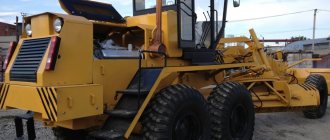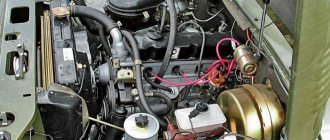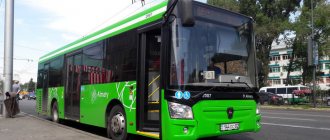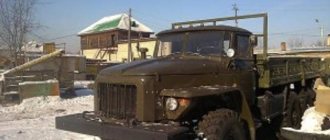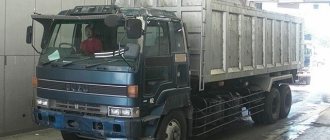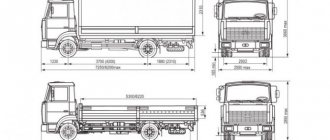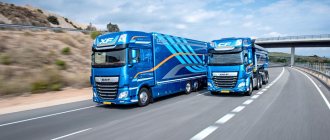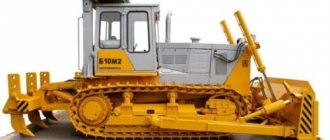MAZ 7907 is a bright representative of Soviet gigantomania , designed to demonstrate the greatness and power of the Soviet state, at the same time the advantages of the socialist system. The technology is unique and has no analogues in the whole world. The vehicle was designed for a load capacity of 220 tons and was supposed to weigh 360 tons when installed.
One can imagine the size of the rocket for the development of which these vehicles were created, if the two created examples of tractors were never used for either military or peaceful purposes. In contrast to the heavy MZKT 79221 tractor, which was used to transport civilian equipment.
But this car crowns the glory of the domestic automobile industry, and is of interest as a brilliant example demonstrating human and technical capabilities in creating heavy-duty tractors.
What kind of car is this, the chassis of which weighs 65.8 tons ?
Historical background of creation
In response to the creation by American specialists of the MX intercontinental missile, the launch weight of which was almost 90 tons, the leadership of the USSR Ministry of Defense decided to develop an analogue. This response was the RT-23 “Molodets” missile, according to the NATO code SS-24 Scalpel, weighing almost one hundred tons. The transport and launch container with the missile inside already weighed one hundred and five tons. Its length was almost twenty-three, and its diameter was two and a half meters. The design dimensions of the launcher were: length - 32 m, height - more than 5.5 m.
But creating a rocket is not enough; a cargo of such mass and dimensions still needs to be transported by roads, and sometimes even without them.
Since the special division of MAZ already had extensive experience in designing super-heavy tractors, this plant received the order for the production of a wheeled vehicle with a carrying capacity of more than 100 tons.
The result of two years of work by the company’s specialists, whose chief designer was Doctor of Technical Sciences B. L. Shaposhnik, Hero of Socialist Labor, laureate of the Lenin and State Prizes of the USSR, became the unique MAZ 7907.
Control system
To turn the MAZ-7907, a unique system is used, which involves the wheels of four front and four rear axles. When the steering wheel rotates, the wheels of the front and rear axles turn in opposite directions.
For correct mutual setting of rotation angles, an automatic control system is used here. Thanks to this, the 28.1-meter-long machine fits into a turning radius of about 27 meters. From the photograph presented in the article, you can clearly understand the joint kinematics of the rotary wheels on the front and rear axles.
Specifications
This project was called “Virgin Land-2”. The first was the eight-axle MAZ 7906 tractor with a lifting capacity of 150 tons.
The MAZ 7907 (24x24) tractor was developed for two years. And in 1985, two samples were assembled for sea trials. The curb weight of the conveyor was 66 tons with a load capacity of 150 tons. The estimated maximum speed on the highway (hard and smooth surface) was 40 km/h. During tests with a mock-up of the launcher, the transporter showed a speed of 25 km/h.
The overall dimensions of the tractor were impressive. Its length was more than 28 meters, width - 4.7 m, and height - almost 4.5 meters. The wheel track width, both front and rear, was more than 3.3 m, and the ground clearance was 465 mm. The turning radius of the chassis is 27 meters. The base of the front and rear bogies is not the same - 9.065 and 9.22 m. The distance between the wheel axles is 1.75; 1.8 or 1.855 m.
Twelve pairs of domestically produced VI-207 drive wheels had dimensions of 1660 x 600-635 mm. That is, the diameter of the wheel was the height of an average person. How small people are next to this monster MAZ 7907, photos from the report on the transportation of the boat demonstrate very clearly.
Chassis
Chassis MAZ 7907
The chassis of this machine, designed for 12 pairs of wheels, has gigantic dimensions - 28 m 187 cm in length and 4 m 70 cm in width. All 12 axes of this monster are driven. The frame of the spinal model consists of two six-axle parts connected to each other by articulated hinges, which is its design feature. The advantage of the hinged design is that the hinges:
- protected the frame from overload and stress;
- allowed to deviate relative to each other by 8o;
- reduced turning radius.
The spinal frame design is another design feature of the chassis, and consists of the presence of a longitudinal transmission pipe that connects the engine crankcases, gearbox clutch, final drives, and transfer case. Inside the transmission pipe there is a thin shaft that acts as a cardan shaft.
The spinal tube provides additional rigidity to the entire frame structure.
Design Features
To ensure such an impressive load capacity, all MAZ 7907 wheel sets had to operate at full load without the wheels hanging out on dirt roads. Therefore, in addition to the suspension design, the spinal-type frame, which maintained rigidity in the horizontal plane, was provided with a power hinge on bearings with one degree of freedom. That is, the platform was two-linked on two six-axle bogies that could move in a vertical plane relative to each other at an angle of up to 8°.
To ensure maneuverability of such a long wheelbase, eight of the twelve pairs of wheels turned. These were the first and last four couples. Moreover, two options for turning were provided. In the first, eight wheels turned in one direction, and eight in the opposite direction. In the second, the turn was synchronous - the so-called “crab” or sideways movement.
Chassis
The MAZ-7907 chassis uses a spinal frame as the basis. In the middle of the latter there is a horizontal hinge, that is, it consists of two 6-axis parts. This design of the frame made it possible to reduce bending loads in the chassis structure. In the photo in the article you can see the MAZ-7907 from the side.
The independent wishbone suspension of its wheels uses hydropneumatic elements. This design made it possible to ensure large vertical suspension travel and high smoothness of movement. Additionally, each pair of MAZ-7907 side wheels has a pneumatic balancing connection, which further improves the chassis' cross-country ability.
Power plant MAZ 7907
MAZ of such carrying capacity and power required an engine with special characteristics. The tractor was equipped with a three-shaft gas turbine engine GTD 1000T FM with a power of 1250 hp. With. Kaluga Engine Plant, which is now called the State Unitary Enterprise “Plant named after. V.Ya. Klimov." The engine was mounted on the front console of the frame under a three-seater cab with three windshields.
Many call the engine a tank engine, although the plant specially created modifications of the base engine for rocket carriers, including the MAZ 7907. Fuel consumption in public literature is indicated only for tank engines, and for the GTD-1000TF with a power of 1100 hp. With. it is 235 g/hp*h, and for the GTD-1250 it is 1250 hp. With. — 225 g/hp*h. Considering that the tractor could cover a hundred kilometers at maximum speed in four hours, it would have to spend about one and a half tons of fuel.
The VSG-625 alternator, installed in a block with the engine, fed the units of the TE-660-24 electromechanical transmission and synchronous air-oil cooling electric motors installed inside the frame, separately for each wheel.
Oil coolers and electrical control units were located under parallel casings at the rear of the chassis.
Diesel "competitor"
The MAZ-7906 chassis was equipped with a ship-borne 1,500-horsepower M-351 diesel engine located in the front overhang of the frame. In front of it there were two separate cabins, each equipped with two windshields.
To transmit torque to the MAZ-7906, two hydromechanical four-speed gearboxes were used. The boxes had gearboxes for driving various auxiliary mechanisms of the machine. Each chassis used 45 driveshafts of varying lengths and configurations. The car was built in two copies in 1984.
Advantages and disadvantages
Compared to the previous MAZ 7906 transporter, the twelve-axle tractor had significant advantages. The best were controllability, soundproofing of the cabin, higher manufacturability and survivability, since the mobility of the installation was maintained even if the eight-wheel drive was damaged.
But the MAZ 7907 tractor also had plenty of shortcomings. The electromechanical transmission was characterized by low performance and low efficiency. In addition, the heavy vehicle had low cross-country ability on soft soils, insufficient acceleration dynamics, and increased axial load.
The design required serious modifications, although prototype rocket carriers were tested successfully. Perhaps the shortcomings would have been eliminated over time, but the Cold War ended and the disarmament stage began, strategic missile forces were no longer needed.
Advantages of the model
- The tractor has a high load capacity - up to 80 tons, which is a high indicator in comparison with similar models of MZKT tractors.
- The machine can withstand strong overloads when overcoming obstacles.
- The 8-axle chassis allows the transport of heavy oil drilling rigs.
- Tire pressure can be adjusted from the driver's cab.
- MZKT 79221 is equipped with an on-board computer that regulates the general condition of the chassis system, tire pressure, and engine condition.
On-board computer of the tractor
MAZ 7907 in action
The unique transporters remained at the factory site, but one of the tractors underwent a kind of test drive, which, however, confirmed the declared characteristics, but ended in tears for it.
After ten years of oblivion, in the summer of 1996, it was necessary to deliver a pleasure boat 40 m long and weighing about 90 tons to its destination by land. Moreover, the owners loaded construction materials into the bow compartment so as not to spend money on their delivery. It was discovered after loading that the centering of the vessel was disturbed, and the stern had to be urgently reloaded. As a result, the total weight of the vessel was approximately one hundred tons.
MZKT specialists spent almost two months preparing the equipment for work. The subframe that existed for attaching the TPK was redesigned. Now these were supports for the bottom of a pleasure boat. We started the gas turbine and checked the electric motors of the wheels. Four engines never started working. One hundred and seventy tons of total mass traveled on twenty wheels. As stated when creating the tractor with serial number 7907.
The MAZ traveled more than 200 km under its own power at a speed of approximately 20 km/h. Only when crossing the bridge over the Berezina River, which was not designed to transport such a mass, did the four-axle MZKT-79091 with a winch and aft mast take over part of the load, raising the stern of the boat above the platform.
When unloading, the truck cranes and the tractor were driven in reverse directly into Lake Naroch. The electric transmission failed the water test. The MAZ 7907 did not make it back to the base under its own power; it was delivered by a factory tractor.
Joint tests
Test runs of the chassis of both models began the following year. Many of them were carried out in the dark on the section of the Mogilev highway between the Minsk ring road and the beginning of the highway to Gomel. Further modifications to the vehicles took place on military territory in the Volgograd region. The MAZ-7907 chassis was delivered there by rail. At the factory, the vehicles were equipped with weight and dimensional mock-ups of the Tselina-2 complex, after which they were sent to the training ground of the 7th Guards Missile Division in the Kalinin (Tver) region.
In total, the tests lasted about a year and ended in September 1987. During this time, the giant MAZ-7907 covered more than 2 thousand km without any complaints about its technical condition. The maximum speed during testing did not exceed 25 km/h. The competitor MAZ-7906 was able to reach speeds of up to 30 km/h.
According to the test results, the technical characteristics of the MAZ-7907 were considered not entirely sufficient. At the same time, the machine showed significant advantages compared to the 8-axle version. The main advantages of the design were:
- Relatively low axle load.
- High acoustic and vibration comfort in the cabin.
- Quick preparation for movement, especially in low temperatures.
- Increased transmission reliability due to the electric drive system.
- Highly adaptable to transportation by rail.
Complaints were caused by the low efficiency of the electric transmission, the vehicle’s low cross-country ability on dirt roads and insufficient acceleration dynamics. Due to the low efficiency of the transmission, the fuel consumption of the MAZ-7907 turned out to be excessive. The diagram shows the main overall dimensions of the chassis.
As a result, both types of chassis did not satisfy the military. During the tests, it was not possible to find a single direction for improving the characteristics of the chassis, so further work on the MAZ-7907 project was considered unpromising. The machines were finally buried by the cessation of work on the Tselina-2 project. After this, both chassis were returned to the plant in Minsk.
Turned page of history
Ten years later, one of the two rocket carriers was assembled at the factory site. The result was such a monumental monument in a museum exhibition on the territory of the Minsk Wheel Tractor Plant. Unfortunately, today there are no problems that would require such powerful equipment as the MAZ 7907 to solve.
Photos of a unique car are not found very often. Sad moments of decline and destruction and black and white photographs now almost twenty years ago, which depict the path from the Berezina River to Lake Naroch - that’s all. But they are enough to show the power of the tractor and the power of thought of Minsk designers led by B. L. Shaposhnik, for whom this project was the last.
The further fate of the cars
Both of these vehicles were stored at the plant for a long time. From time to time they were involved in performing various unique works. One of these tasks was the transportation of a 90-ton motor ship along a route of almost 250 km in 1996. Initially, the MAZ-7907 chassis was supposed to act as a giant trailer and be towed by an MZKT-79221 tractor. But it was only able to drag the road train for about 30 km, after which it broke down.
The chassis made the further journey in one direction on its own. During unloading, it was driven into the water without any sealing of the components. Such a test and a long downtime did not benefit the technology - all the traction motors on the MAZ-7907 failed, and the car was brought back to the plant in tow. In the photographs you can see the process of transporting the ship.
In 2006, one chassis was assembled from two, which is currently undergoing restoration. Upon completion of the repair, the MAZ record holder is planned to be exhibited in the museum of the MZKT Volat wheeled tractor plant.
Fuel consumption rate for a truck + trailer
You can add a topic to your favorites list and subscribe to email notifications.
Yulia Vishenka [email protected] Belarus, Minsk Wrote 828 messages Write a private message Reputation: Group: Moderators I want to draw the moderator's attention to this message because: A notification is being sent.
When you find a man, you lose your mind. Finding the truth, you lose faith. When you find power, you lose honor. And only after losing everything do you find freedom. But I’m not a Buddhist, why do I need such freedom?
filaretovna [email protected] Belarus, Brest Wrote 493 messages Write a private message Reputation: I want to draw the moderator's attention to this message because: A notification is being sent. Yulia Vishenka [email protected] Belarus, Minsk Wrote 828 messages Write a private message Reputation: Group: Moderators I want to draw the moderator's attention to this message because: A notification is being sent.
When you find a man, you lose your mind. Finding the truth, you lose faith. When you find power, you lose honor. And only after losing everything do you find freedom. But I’m not a Buddhist, why do I need such freedom?
Marina [email protected] Belarus, Minsk Wrote 151 messages Write a private message Reputation: I want to draw the moderator's attention to this message because: A notification is being sent. SWetlana [email hidden] Belarus, Minsk, Bobruisk Wrote 8632 messages Write a private message Reputation: I want to draw the moderator's attention to this message because: A notification is being sent. Most people are only as happy as they decide to be. (Lincoln A.)
D.V. [e-mail hidden] Belarus, Vitebsk Wrote 30471 messages Write a private message Reputation: Group: Moderators I want to draw the moderator's attention to this message because: A notification is being sent. Uninvited <B.K.
worse than the Tatar
SWetlana [e-mail hidden] Belarus, Minsk, Bobruisk Wrote 8632 messages Write a private message Reputation: Marina wrote:
Tell me, what if a MAZ 555102-223 car with a carrying capacity of 10 tons carries 15 tons! at 28 km, then what will be the additional expense? — 1.3*28/100? or something is wrong. Help! the driver shouts that he is using more fuel than we are charging him!
Transmission
Each wheel was driven by an individual electric motor, model DST180-6, with a power of 30 kW each. The motors were placed inside the frame and drove the wheels through axle shafts with cardan joints. The wheel hubs had planetary gearboxes. The transmission design included additional matching gearboxes.
The initial design of the MAZ-7907 provided for full oil cooling of all traction engines. But the experimental machines had engines with a combined air-oil heat removal system. Engine control units and their radiators were located in cooling modules installed on the sides of the frame at the rear of the chassis. From above, these devices were covered with removable casings with vents for supplying cooling air. The photo clearly shows the power cables and cooling system pipelines leading to the modules.
The wheels were equipped with special tires VI-207 with low internal pressure, produced at the tire plant in Voronezh.
